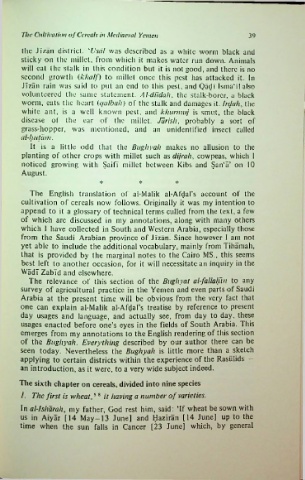Page 53 - Arabian Studies (I)
P. 53
The Cultivation of Cereals in Mediaeval Yemen 39
the JTzan district. 4Usal was described as a white worm black and
sticky on the millet, from which it makes water run down. Animals
will cat the stalk in this condition but it is not good, and there is no
second growth (k/ialf) to millet once this pest has attacked it. In
JTzan rain was said to put an end to this pest, and QadT Isma‘11 also
volunteered the same statement. Al-diidah, the stalk-borer, a black
worm, eats the heart (qalbah) of the stalk and damages it. Irdah, the
white ant, is a well known pest, and khurmuj is smut, the black
disease of the ear of the millet. Jarish, probably a sort of
grass-hopper, was mentioned, and an unidentified insect called
aid jut tam.
It is a little odd that the Bughyah makes no allusion to the
planting of other crops with millet such as dijrah, cowpeas, which I
noticed growing with SaifT millet between Kibs and San4a’ on 10
August.
The English translation of al-Malik al-Afdal’s account of the
cultivation of cereals now follows. Originally it was my intention to
append to it a glossary of technical terms culled from the text, a few
of which are discussed in my annotations, along with many others
which I have collected in South and Western Arabia, especially those
from the Saudi Arabian province of JTzan. Since however I am not
yet able to include the additional vocabulary, mainly from Tihamah,
that is provided by the marginal notes to the Cairo MS., this seems
best left to another occasion, for it will necessitate an inquiry in the
WadT ZabTd and elsewhere.
The relevance of this section of the Bughyat al-falla/iin to any
survey of agricultural practice in the Yemen and even parts of Saudi
Arabia at the present time will be obvious from the very fact that
one can explain al-Malik al-Afdal’s treatise by reference to present
day usages and language, and actually see, from day to day, these
usages enacted before one’s eyes in the fields of South Arabia. This
emerges from my annotations to the English rendering of this section
of the Bughyah. Everything described by our author there can be
seen today. Nevertheless the Bughyah is little more than a sketch
applying to certain districts within the experience of the Rasulids -
an introduction, as it were, to a very wide subject indeed.
The sixth chapter on cereals, divided into nine species
1. The first is wheat,s 8 it having a number of varieties.
In al-Isharah, my father, God rest him, said: Tf wheat be sown with
us in Aiyar [14 May-13 June] and HazTran [14 June] up to the
time when the sun falls in Cancer [23 June] which, by general

